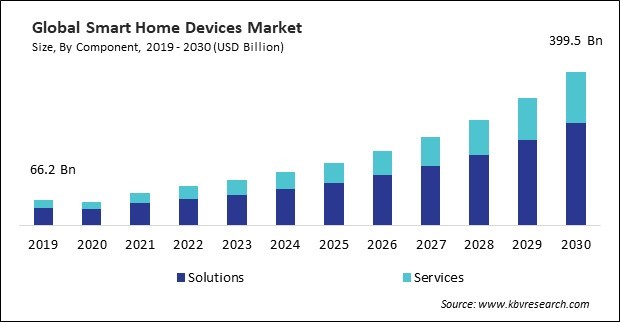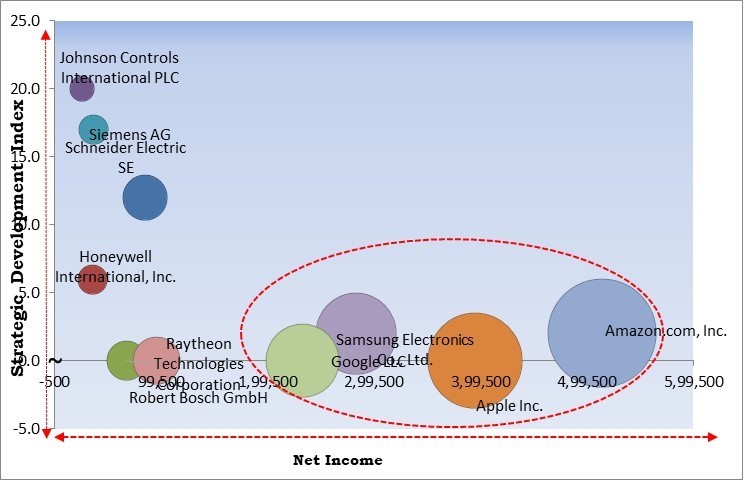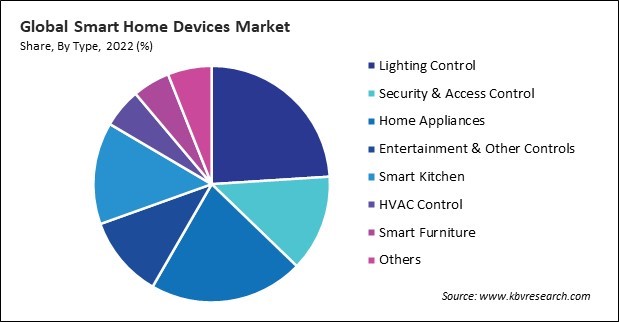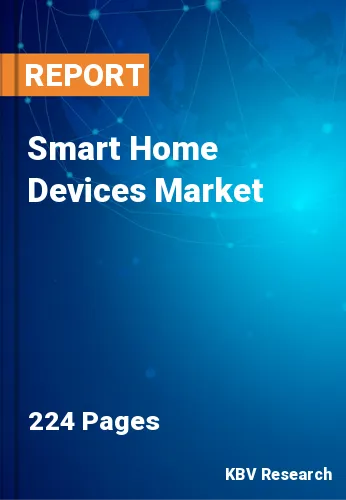“Global Smart Home Devices Market to reach a market value of USD 399.5 Billion by 2030 growing at a CAGR of 19.2%”
The Global Smart Home Devices Market size is expected to reach $399.5 billion by 2030, rising at a market growth of 19.2% CAGR during the forecast period.
Smart home appliances seamlessly integrate with other devices and platforms, allowing users to create interconnected and automated home environments. Thus, the home appliance segment captured 21.1% revenue share in the market 2022. Integration with smart hubs and home automation systems enables users to control multiple appliances with simple voice commands or automated routines, enhancing the overall experience.

The major strategies followed by the market participants is Partnership as the key developmental strategy to keep pace with the changing demands of end users. For instance, In November 2022 Amazon.com, Inc. came into partnership with Samsung Electronics, a South Korean multinational major appliance and consumer electronics corporation. Through this partnership, Amazon.com, Inc. would provide smart things and Alexa users to leverage Matter's multi-admin feature, broadening communication and capabilities across various devices. Additionally, In October, 2022, Siemens AG came into partnership with, Qualcomm, an American multinational corporation. Through this partnership, Siemens AG would revolutionize building automation in the Americas by implementing a 5G private network (PN) based on the Snapdragon® X55 5G Modem-RF System.
Based on the Analysis presented in the KBV Cardinal matrix; Amazon.com, Inc., Apple Inc., and Samsung Electronics Co., Ltd. are the forerunners in the Smart Home Devices Market. Companies such as Raytheon Technologies Corporation, Siemens AG, and Schneider Electric SE are some of the key innovators in the Smart Home Devices Market. In August 2023, Siemens AG came into partnership with Sonepar, a wholesale company in Paris. Through this partnership, Siemens AG would enhance and modernize building materials to achieve greater efficiency and intelligence, by incorporating HVAC devices and building automation systems into its offerings.

Modern lifestyles are increasingly fast-paced and hectic, leaving consumers limited time for mundane tasks. Smart home devices promise to simplify daily routines and automate repetitive chores, allowing individuals to reclaim time for more meaningful activities. Smart home devices offer a high degree of customization and personalization.
Additionally, according to the Office for National Statistics, 92% of adults in the UK were internet users in 2020, up from 91% in 2019. As internet connectivity expands and evolves, the market is poised for continued innovation and transformation, shaping the future of connected living environments. In conclusion, the increasing internet penetration is driving the market's growth.
Smart home devices often cost more upfront than traditional, non-connected alternatives. This is primarily due to the inclusion of advanced technology components, sensors, connectivity modules, and software features that enable smart functionality. For example, smart thermostats, security cameras, and lighting systems may cost more than their conventional counterparts due to the added features and capabilities. Thus, the high initial costs of devices are impeding the market's growth.
On the basis of type, the market is segmented into security & access control, HVAC control, entertainment & other controls, smart kitchen, lighting control, home appliances, smart furniture, and others. The lighting control segment recorded 23.9% revenue share in the market in 2022. The increasing affordability, convenience, energy efficiency, and integration capabilities of smart lighting solutions are driving their popularity among consumers looking to upgrade their homes with smart technology.

Based on component, the market is bifurcated into solutions and services. The services segment attained 31.9% revenue share in the market in 2022. As the number and variety of it increase, consumers often encounter challenges in integrating and configuring these devices to work together seamlessly.
Free Valuable Insights: Global Smart Home Devices Market size to reach USD 399.5 Billion by 2030
Region-wise, the market is analyzed across North America, Europe, Asia Pacific, and LAMEA. In 2022, the Asia Pacific region generated 29.4% revenue share in the market. Many countries in the Asia Pacific region are experiencing rapid urbanization and population growth, leading to increased demand for housing and infrastructure solutions.
| Report Attribute | Details |
|---|---|
| Market size value in 2022 | USD 100.4 Billion |
| Market size forecast in 2030 | USD 399.5 Billion |
| Base Year | 2022 |
| Historical Period | 2019 to 2021 |
| Forecast Period | 2023 to 2030 |
| Revenue Growth Rate | CAGR of 19.2% from 2023 to 2030 |
| Number of Pages | 224 |
| Number of Tables | 303 |
| Report coverage | Market Trends, Revenue Estimation and Forecast, Segmentation Analysis, Regional and Country Breakdown, Competitive Landscape, Porter’s 5 Forces Analysis, Company Profiling, Companies Strategic Developments, SWOT Analysis, Winning Imperatives |
| Segments covered | Component, Type, Region |
| Country scope |
|
| Companies Included | Johnson Controls International PLC, Schneider Electric SE, Siemens AG, Honeywell International, Inc., Amazon.com, Inc., Apple Inc., Google LLC (Alphabet Inc.), Robert Bosch GmbH, Raytheon Technologies Corporation, Samsung Electronics Co., Ltd. (Samsung Group) |
By Component
By Type
By Geography
The Market size is projected to reach USD 399.5 billion by 2030.
Increasing consumer demand for convenience are driving the Market in coming years, however, High initial costs of smart home devices restraints the growth of the Market.
Johnson Controls International PLC, Schneider Electric SE, Siemens AG, Honeywell International, Inc., Amazon.com, Inc., Apple Inc., Google LLC (Alphabet Inc.), Robert Bosch GmbH, Raytheon Technologies Corporation, Samsung Electronics Co., Ltd. (Samsung Group)
The expected CAGR of this Market is 19.2% from 2023 to 2030.
The Solutions segment is leading the Market, by Component in 2022; there by, achieving a market value of $266.3 billion by 2030.
The North America region dominated the Market, by region in 2022, and would continue to be a dominant market till 2030; there by, achieving a market value of $127.4 billion by 2030.
Our team of dedicated experts can provide you with attractive expansion opportunities for your business.

 Drivers
Drivers
 Restraints
Restraints
 Opportunities
Opportunities
 Challenges
Challenges
